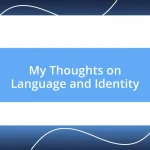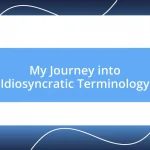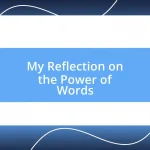Key takeaways:
- Historical linguistics reveals the evolution of words and language relationships, reflecting cultural shifts and human experiences.
- Key concepts such as sound shifts, semantic change, and language contact illustrate how languages influence and adapt over time.
- Applications of historical linguistics impact various fields, from deciphering ancient texts to enhancing technology like natural language processing.

Understanding Historical Linguistics
Historical linguistics, to me, feels like piecing together a captivating puzzle. I remember the first time I noticed how words evolve; it was like discovering hidden secrets in my favorite stories. For example, I was fascinated to find out that the word “father” in English traces back to the Proto-Indo-European *pH₂tér, showing how interconnected our languages truly are.
What struck me most about historical linguistics is its ability to reflect cultural shifts and societal changes. Languages are like living organisms; they adapt, grow, and sometimes even die out. Have you ever considered how the way we speak reveals so much about our history and identity? I still find it intriguing to explore terms that have fallen out of use, illuminating how our values and lifestyles have transformed.
Through my studies, I came to realize that historical linguistics is not merely about tracking word changes but also understanding the human experience behind those changes. Each linguistic evolution tells a story of migration, conquest, or innovation. For me, it’s like walking through history—each phonetic shift represents a moment in time, linking us to the experiences of our ancestors.

Key Concepts in Linguistic Change
Key Concepts in Linguistic Change
One of the most fascinating concepts in linguistic change is the idea of sound shifts. These shifts occur when phonetic characteristics of words change over time. For instance, I vividly recall learning about the Great Vowel Shift in English. It was a remarkable transformation that altered the pronunciation of long vowels, shaping how we communicate today. It made me appreciate how such shifts can redefine a language’s identity.
Another critical concept is semantic change, which refers to the evolution of a word’s meaning. Sometimes, words take on new connotations that reflect societal changes, like how the word “gay” has transitioned from meaning joyful to referring primarily to sexual orientation. I remember discussing this with classmates and realizing how language adapts to our cultural contexts; it’s almost like witnessing a living narrative unfold before our eyes.
Lastly, the phenomenon of language contact is vital in understanding how languages influence each other. When speakers of different languages interact, they often borrow words, phrases, and even structures. I once experienced this firsthand while traveling abroad, picking up slang that made it feel like I was blending into a new culture. It struck me that language is not just a means of communication; it’s a bridge between communities and histories.
| Concept | Description |
|---|---|
| Sound Shifts | Changes in pronunciation that occur over time, reflecting historical linguistic evolution. |
| Semantic Change | Alterations in a word’s meaning, influenced by cultural and societal shifts. |
| Language Contact | The interaction between speakers of different languages, leading to borrowing and influence. |

Major Theories of Language Evolution
The study of language evolution has given rise to several fascinating theories that explain how we communicate. One prominent theory is the monogenesis hypothesis, which proposes that all languages descended from a single ancestral language. I remember grappling with this idea during my studies, feeling wonder at the thought that we might have all started from one source. It felt like uncovering a shared heritage among diverse cultures. On the other hand, the polygenesis hypothesis suggests that languages evolved independently in different regions. This perspective always intrigued me because it highlights how human creativity often leads to similar solutions, like the development of words for “water” across languages, each reflecting its unique environment.
Here are some notable theories in language evolution:
-
Monogenesis Hypothesis: Claims all languages derive from one singular ancestral language.
-
Polygenesis Hypothesis: Argues that languages arose independently in various regions, emphasizing the creativity of human communication.
-
Out-of-Africa Theory: Suggests that modern humans migrated from Africa, bringing their languages with them, influencing linguistic diversity globally.
-
Creole and Pidgin Development: Opens a window into how new languages can form from the blending of different linguistic elements, often in a colonial context.
Delving into these theories has certainly enriched my understanding of language. It feels like piecing together a grand tapestry, where each thread represents a unique story of human connection. I often reflect on how language not only serves as a tool for communication but also represents a deep reservoir of human experience and interaction.

Methods Used in Historical Linguistics
When it comes to uncovering the layers of historical linguistics, one of the primary methods I find intriguing is the comparative method. This technique allows linguists to systematically compare languages to identify common ancestry and reconstruct proto-languages. I remember the thrill I felt when I first pieced together similarities between Latin and the Romance languages. It was like solving a mystery, and I realized how vital this method is for tracing the evolution of languages and understanding what lies beneath the surface of our modern tongues.
Another significant approach is the study of internal reconstruction, where changes within a language are analyzed to derive earlier forms. This method often feels like looking through a linguistic time capsule. For instance, while taking a deep dive into Old English, I was fascinated by how certain irregular forms and inconsistencies could hint at rules that once governed the language. Have you ever considered how such hidden patterns can reveal so much about our linguistic past? This deep exploration always leaves me in awe of the intricate web of language development.
Additionally, there’s the role of textual analysis in historical linguistics. Examining ancient manuscripts and texts can illuminate not only language changes but also social and cultural shifts. I recall poring over an old text where the language reflected the values and beliefs of its time. It felt like I was not just reading words but stepping back into history, feeling the pulse of a culture long gone. Understanding how language documents human experience drives home the point that linguistics is much more than just words; it’s a reflection of who we are and how we connect with the world around us.

Notable Figures and Their Contributions
When discussing notable figures in historical linguistics, one cannot overlook Sir William Jones. His groundbreaking observation in the late 18th century about the similarities between Sanskrit, Latin, and Greek fundamentally changed the way we view language relationships. I remember reading about his famous quote, “The Sanskrit language is of a wonderful structure; more perfect than the Greek, more copious than the Latin, and more exquisitely refined than either.” It struck me how one person’s curiosity could ignite an entire field of study!
Another pivotal figure is Ferdinand de Saussure, who introduced the concepts of the linguistic sign and the arbitrary nature of the relationship between signifiers and signified. As I delved into his ideas, I was struck by how they resonated with my own experiences of learning different languages. It’s fascinating to think about how meanings can shift and evolve depending on cultural context. Have you ever noticed that feeling when a word in another language captures a concept that seems untranslatable in your own? That moment reminds me of Saussure’s work – it captures the fluidity and beauty of human expression.
Lastly, I must mention Noam Chomsky, whose theories on universal grammar revolutionized our understanding of language acquisition. His argument that humans are born with an innate ability to learn language always made me ponder the unconscious connections we make as children. I vividly recall my niece speaking her first words and marveling at how natural it seemed, as if she was tapping into a prewritten script of sorts. This notion of a built-in language framework left me thinking: how much of our ability to communicate is hardwired versus learned? Chomsky’s contributions really make you reflect on the profound complexity of language.

Case Studies of Language Development
The evolution of language can be vividly illustrated through the case study of English dialects. I once spent a summer in England, exploring the rich variety of accents and expressions that exist even within small geographical areas. It struck me how these dialects carry historical fingerprints, showcasing centuries of migration, trade, and cultural interactions. Have you ever marveled at how a simple phrase can differ dramatically just a few miles down the road? That observation really made me appreciate the ongoing development of language as a living entity.
Another fascinating example is the transition from Old English to Middle English. I recall reading Chaucer’s The Canterbury Tales and struggling to grasp the language at first. It was like deciphering a code! The shift in vocabulary and grammar during this era illustrates how political influences and the Norman Conquest played a pivotal role in shaping English. The blend of Old English and Norman French created a linguistic tapestry that represents a vibrant cultural exchange—don’t you love how language tells stories beyond just words?
Take the case of Creole languages, for instance. I spoke with a linguist who focuses on Caribbean Creoles, and it was captivating to learn how these languages emerged from a blending of colonial languages, African languages, and indigenous tongues. In the context of history, I felt a sense of empathy when she explained that Creole is not merely a simplified version of another language; it’s a rich linguistic system with its own rules and structures. Reflecting on this made me wonder: how many stories of resilience and identity are woven into the fabric of languages around the world? The development of Creoles showcases the complexity and adaptability of human expression in the face of social change.

Applications of Historical Linguistics Today
The applications of historical linguistics today extend far beyond academic interest; they play a vital role in various practical fields. For instance, I once attended a lecture where a linguist discussed how historical linguistic methods help in deciphering ancient texts. Hearing about the painstaking work of reconstructing lost languages made me appreciate how much our understanding of history hinges on language. It’s fascinating to consider, isn’t it? The way words can unlock the past feels almost magical.
Another striking application is found in the realm of sociolinguistics, where understanding historical context enhances our grasp of contemporary dialects and language use. I remember chatting with a friend who works in language preservation, and she shared how historical linguistics informs efforts to support endangered languages. It left me pondering the power of words not just to communicate but to preserve culture and identity. Have you ever thought about the stories behind the phrases we take for granted?
Additionally, the field isn’t solely academic; it influences technology, particularly in natural language processing (NLP). I had a conversation with a software engineer who explained how algorithms for voice recognition systems rely on insights from historical linguistics. As she described her work, I found myself amazed at how understanding the evolution of language helps these systems better grasp nuances in speech. It really makes me wonder: how many breakthroughs in our daily lives are tethered to our understanding of language history? The interplay between historical linguistics and technology demonstrates that the past continues to shape the future in unexpected ways.












